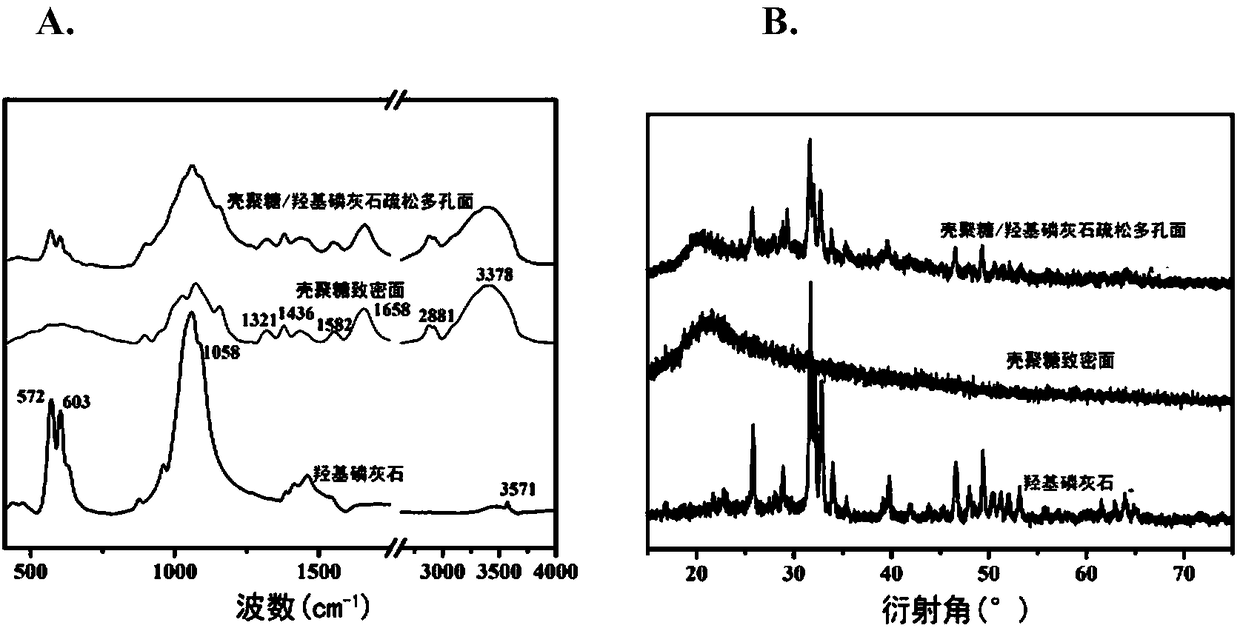GTR (guided tissue regeneration) membrane and preparation method thereof
A technology that guides tissue regeneration and loosens pores. It can be used in surgery, medical science and other directions. It can solve the problems of complex production process, high price, and inability to meet the requirements, and achieve the effect of simple operation steps, good biocompatibility and mild reaction system.
- Summary
- Abstract
- Description
- Claims
- Application Information
AI Technical Summary
Problems solved by technology
Method used
Image
Examples
Embodiment 1
[0087] Example 1: Preparation of a structurally asymmetric guided tissue regeneration membrane with osteogenic activity
[0088] (1) Configuration of chitosan solution:
[0089] Weigh 10g of chitosan powder in 900ml of ultrapure water and stir to disperse evenly, then add 32mL of 1.2M dilute hydrochloric acid solution, and set the volume to 1000mL. Stir overnight to completely dissolve, dilute hydrochloric acid to adjust the pH to between 4.5-5.5, centrifuge at 7500rpm / min at 4°C to remove insoluble impurities and obtain a 1% chitosan solution for subsequent use.
[0090] (2) Configuration of chitosan-nanometer hydroxyapatite composite solution:
[0091] Weigh 400 mg of nano-hydroxyapatite powder and add it into 100 ml of the chitosan solution described in step (1), stir overnight until completely dispersed and set aside.
[0092] (3) Preparation of chitosan / chitosan-nano hydroxyapatite asymmetric bilayer membrane:
[0093] Before film formation, add 25 μl / ml of hydrogen pe...
Embodiment 2
[0097] Example 2: Physicochemical characterization of structurally asymmetric guided tissue regeneration membrane with osteogenic activity
[0098] The Fourier total reflection infrared spectrum and X-ray diffraction spectrum of CS / CS-nHAps double-sided figure 2 shown in A.
[0099] Compared with the CS surface, the CS-nHAps surface after adding nHAps appeared on the infrared spectrum at 573cm -1 、601cm -1 and 1084cm -1 PO 3- 4 The characteristic absorption peak and stretching vibration peak of the bending deformation also appeared at 1590cm -1 、1562cm -1 and 1658cm -1 The characteristic absorption peaks of -NH2 and C=O.
[0100] At the same time, if figure 2 On the X-ray spectrum shown in B, a series of characteristic diffraction peaks of nHAps appeared in the CS-nHAps layer, indicating that the loose porous layer is a composite layer of chitosan and nano-hydroxyapatite.
Embodiment 3
[0101] Example 3: Morphological characterization of a structurally asymmetric guided tissue regeneration membrane with osteogenic activity
[0102] After the CS / CS-nHAps asymmetric double-layer film was vacuum-dried for 24 hours, the loose surface and the dense surface of the sample were respectively pasted on the copper platform. Loose porous surface and dense surface morphology (accelerating voltage is 20kV), such as image 3 shown.
[0103] The loose and porous surface is a three-dimensional network structure with a thickness of 450±30 μm. The pores are interconnected and regular. The average pore size is about 390 μm and the porosity is 90±2%. It is beneficial to the absorption of nutrients and the discharge of metabolic waste, as well as the proliferation and differentiation of osteoblasts.
[0104] The dense surface is relatively flat and smooth, with a thickness of 82±6μm, no obvious pore structure, and a porosity of 5±1%. It will play a certain barrier effect on fib...
PUM
| Property | Measurement | Unit |
|---|---|---|
| thickness | aaaaa | aaaaa |
| thickness | aaaaa | aaaaa |
| thickness | aaaaa | aaaaa |
Abstract
Description
Claims
Application Information
 Login to View More
Login to View More - R&D
- Intellectual Property
- Life Sciences
- Materials
- Tech Scout
- Unparalleled Data Quality
- Higher Quality Content
- 60% Fewer Hallucinations
Browse by: Latest US Patents, China's latest patents, Technical Efficacy Thesaurus, Application Domain, Technology Topic, Popular Technical Reports.
© 2025 PatSnap. All rights reserved.Legal|Privacy policy|Modern Slavery Act Transparency Statement|Sitemap|About US| Contact US: help@patsnap.com



